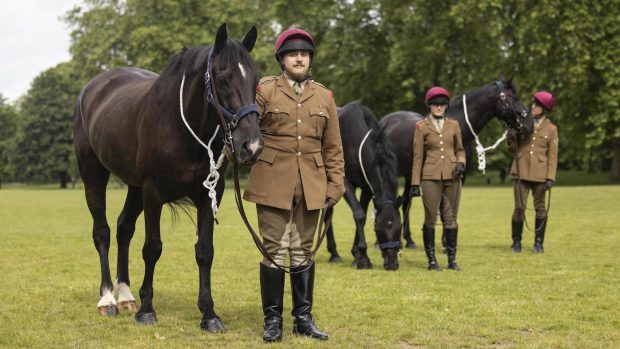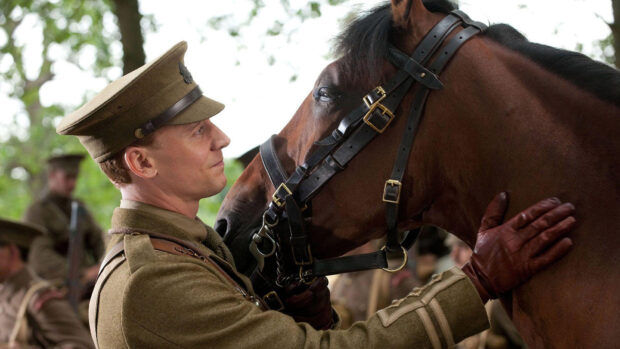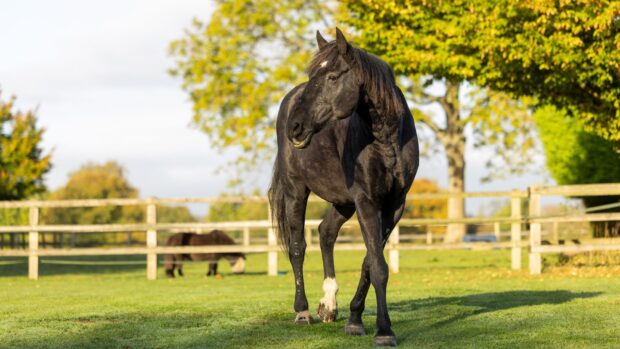Anyone who has seen the Musical Ride of the King’s Troop Royal Horse Artillery knows the skill, stamina and training required of both soldiers and horses to perform such an array of manoeuvres. Away from shows like Royal Windsor, The King’s Troop also takes the lead when parading with its guns at ceremonial events such as Trooping the Colour, despite the Household Cavalry being first in the Army’s order of precedence, and will be on display at the King’s coronation in May.
Founded in 1793, the Royal Horse Artillery fought in French Revolutionary and Napoleonic Wars right through to World War I, providing mobile fire support to the fast-moving cavalry. The cavalry was then mechanised during the interwar years, and 1946 saw the formation of the regiment as The Riding Troop, later renamed The King’s Troop after inspection by King George VI – The King’s Troop is now the only remaining mounted unit of the Royal Horse Artillery.
It was a gun carriage of the Royal Horse Artillery that bore the coffin of Queen Elizabeth II, her father King George VI and Princess Diana from Buckingham Palace to Westminster. As the monarch’s Mounted Ceremonial Battery, the King’s Troop Royal Horse Artillery also fires Royal Salutes for grand occasions of State.
The regiment includes mounted gunners, gun team drivers, farriers, saddlers, tailors and logistics, and is based at Royal Artillery Barracks in Woolwich. There are 120 horses in the regiment, 13 of which are officers’ chargers and the rest “ride and drive”, usually sourced in Ireland before being brought over for training at the Defence Animal Training Regiment in Melton Mowbray, Leicestershire.
While the Household Cavalry select only black horses (greys for the trumpeters and band), the horses of the King’s Troop are selected to be a certain type and range of colours. The six guns, each weighing 1.5t, are drawn by teams of six horses, each team called a sub-division, and range from light bays in A Sub-division, to blacks in F Sub-division.
The front horses are called leads and are the largest of the team at around 16hh, the centre horses are around 15.3hh and the wheelers at the back are shorter and stockier at 15.2hh. As with horses of the Household Cavalry, once the initial training is done, the horses (known at this stage as remounts) of the Royal Artillery then move to London to complete their training with the specialist equipment of the regiment.
While the Musical Ride is highly entertaining to watch, it is based on drills that had a real purpose on the battlefield. The 13-pounder guns used date back to between 1912 and 1918, and have seen active service in both World Wars; with the exception of the ‘George gun’, which is reserved exclusively for the funeral of the reigning monarch, all of the guns are used daily on parade, in training or at events.
At any one time, there are approximately 140 men and women in the King’s Troop. Having initially been allowed to apply in 1996, almost 50% per cent of the Troop are now women, making it one of the units with the highest balance by sex in the Army. When Major Erica Bridge became commanding officer of the King’s Troop in 2007, she was the first woman to do so in the history of the Household Division .
You might also be interested in…

The Household Cavalry: its history, the regiments and the famous Cavalry Black horses

The Band of the Household Cavalry: the horses behind the music

Two showjumpers as you’ve never seen them before, on a day with the Household Cavalry

Subscribe to Horse & Hound magazine today – and enjoy unlimited website access all year round
Horse & Hound magazine, out every Thursday, is packed with all the latest news and reports, as well as interviews, specials, nostalgia, vet and training advice. Find how you can enjoy the magazine delivered to your door every week, plus options to upgrade your subscription to access our online service that brings you breaking news and reports as well as other benefits.




